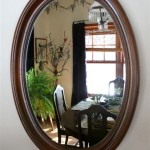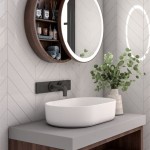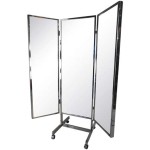What Size Should A Mirror Be Over Vanity?
Determining the appropriate size of a mirror to place above a vanity is a crucial step in bathroom design. The mirror's size influences both the aesthetic appeal and the functionality of the space. A mirror that is too small can appear disproportionate, while one that is too large can overwhelm the vanity and the surrounding area. Several factors must be considered to achieve the right balance, including the vanity's dimensions, the bathroom's overall size, and the intended style.
Selecting the correct mirror size goes beyond mere aesthetics. A well-sized mirror significantly enhances the bathroom's lighting, making the space appear brighter and more open. It also improves the usability of the vanity for tasks such as applying makeup, shaving, and styling hair. Understanding the principles of proportion, scale, and personal preference is essential in making an informed decision about the ideal mirror size for a given vanity.
Vanity Size as a Primary Determinant
The size of the vanity is the most fundamental factor in deciding upon the ideal mirror dimensions. As a general guideline, the mirror should be at least as wide as the vanity. A mirror narrower than the vanity often looks unbalanced and inadequate. For single vanities, this is a relatively straightforward calculation. If the vanity is 30 inches wide, then a mirror of at least 30 inches in width is recommended. However, aiming for a mirror slightly wider than the vanity can create a more visually pleasing and harmonious effect. A 36-inch mirror, for example, would be a suitable choice for a 30-inch vanity.
For double vanities, the considerations are slightly different. There are two common approaches: using a single, large mirror spanning the width of both vanities or installing separate mirrors above each vanity. If opting for a single mirror, it should ideally extend at least to the outer edges of both vanities. This creates a unified and streamlined look. If choosing individual mirrors, each mirror should be at least as wide as the vanity it sits above, with some space between the mirrors to avoid a cluttered appearance. The space between the individual mirrors should be carefully considered to ensure visual balance.
The height of the vanity also plays a role, although less directly than the width. A taller vanity may visually support a taller mirror, while a shorter vanity might benefit from a shorter mirror. The goal is to maintain a sense of proportion between all elements in the space. Standard vanity heights are typically around 30 to 36 inches. Adjustments to the mirror's height can be made based on the ceiling height and personal preference.
Bathroom Dimensions and Spatial Considerations
The overall size of the bathroom should also influence the mirror size selection. In smaller bathrooms, a larger mirror can create the illusion of more space by reflecting light and expanding the perceived dimensions of the room. Conversely, in larger bathrooms, a smaller mirror might get lost and appear insignificant. A larger bathroom can accommodate a more substantial mirror installation without feeling overwhelming.
The mirror's placement relative to other bathroom fixtures and architectural details is also important. The distance between the vanity and the ceiling, as well as the proximity to adjacent walls or cabinets, should be considered. If the space above the vanity is limited, a taller, narrower mirror might be the best option. If there is ample space, a wider, shorter mirror could be more appropriate. The mirror's size should complement the existing architectural elements rather than compete with them.
Consider the sightlines within the bathroom. From the doorway and other vantage points, assess how the mirror will appear in relation to the rest of the room. A mirror that is too large might dominate the view and detract from other design features. A mirror that is too small might be overlooked and fail to make a visual impact. The ideal size will enhance the overall aesthetic without overpowering the space.
Lighting and Functionality Implications
The primary function of a bathroom mirror is to provide a clear and well-lit reflection for grooming tasks. Therefore, the mirror's size should be adequate for the user to see their entire face and upper body comfortably. Insufficient mirror size can lead to straining and difficulty in performing tasks such as makeup application or shaving. The mirror's vertical dimension is particularly important for this purpose.
The type of lighting used in the bathroom also interacts with the mirror size. If the bathroom has limited natural light, a larger mirror can help to maximize the reflection of artificial light, making the space brighter and more usable. Conversely, if the bathroom has abundant natural light, a smaller mirror might be sufficient to provide adequate illumination. The positioning of light fixtures is also crucial. Sconces placed on either side of the mirror offer balanced and flattering lighting, while overhead lighting can create shadows.
Mirrors with integrated lighting are becoming increasingly popular, offering a convenient and stylish way to enhance illumination. These mirrors often have LED lights built directly into the mirror's surface, providing even and shadow-free lighting. When selecting a mirror with integrated lighting, it is important to consider the brightness and color temperature of the lights, as well as the mirror's overall size. The size of the illuminated area should be adequate for the user's needs, and the color temperature should be appropriate for the bathroom's overall design scheme. A mirror that is too small, even with integrated lighting, might not provide sufficient illumination for all tasks.
Styles, Shapes, and Personal Preferences
While the vanity size and bathroom dimensions provide a foundation for determining the appropriate mirror size, personal style and preferences also play a significant role. The shape and style of the mirror can dramatically impact the bathroom's overall aesthetic. A rectangular mirror is a classic and versatile choice, suitable for a wide range of bathroom styles. A round or oval mirror can add a touch of softness and elegance. An arched mirror can create a focal point and add architectural interest.
The frame style is another important consideration. A framed mirror can add a decorative element and complement the bathroom's color scheme and hardware finishes. A frameless mirror offers a clean and minimalist look, allowing the mirror to blend seamlessly into the surrounding space. The choice between a framed and frameless mirror depends on the desired aesthetic and the overall design of the bathroom.
Ultimately, the ideal mirror size is a balance between practicality and aesthetics. It should be large enough to provide adequate reflection and illumination, but not so large that it overwhelms the space. It should complement the vanity and the bathroom's overall design, reflecting the homeowner's personal style and preferences. Experimenting with different sizes and shapes is often necessary to find the perfect fit. Using visual aids, such as cardboard cutouts or online design tools, can help to visualize different mirror sizes in the space before making a final decision.

Bathroom Mirror Size Calculator

Bathroom Mirror Size Calculator

How To Choose The Best Size Mirror Olde Good Things

How To Choose The Perfect Vanity Mirror Ryan S All Glass

How To Pick And Hang The Perfect Bathroom Mirror Roomhints

The Right Height For Your Bathroom Sinks Mirrors And More

How To Choose A Bathroom Mirror

Better Bevel 20 In W X 28 H Frameless Rectangular Beveled Edge Bathroom Vanity Mirror 17106 The Home Depot

How To Pick And Hang The Perfect Bathroom Mirror Roomhints

How To Choose A Bathroom Mirror








